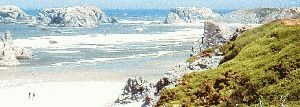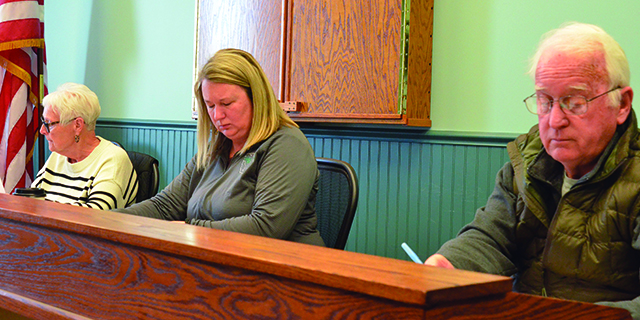LORD BENNETT’S GORSE
Published 12:00 am Saturday, June 10, 2006

- OUR FURZE RUNNETH OVER: Irish furze, better known in our part of the world as gorse, pours over the cliffs along a beach near Bandon. (Staff photos/CHRIS BAXTER).
Once upon a time, many years ago, a wee bit o’ the Irish landscape known as Irish furze found its way to an ocean-side estate near Bandon.
And to say the stuff has done pretty well for itself in the last 125 years would be more than just a wee bit o’ an understatement. Just how much of an understatement is immediately apparent to anyone exploring the beaches and byways of the coastline for miles north and south of Bandon.
In this area, when it comes to furze, or gorse as it is commonly known as here (not to be confused with another wide-spread European import Scotch broom), the usually hyperbolic term "ubiquitous" doesn’t seem quite so
hyperbolic.
So just how did this particular plant, a native western European plant species, become so profuse along so much of our southern Oregon coastline?
The beginning of this gorse story begins with one self-annointed "Lord" George Bennett, an Irish immigrant who came to this area with his family in the 1870s, eventually settling near a slight settlement at the mouth of the Coquille River.
He was soon a leading citizen of such influence in the area that he was able to rename the fledgling community in honor of his former County Cork home in
Ireland Bandon.
But that wasn’t the only thing he transplanted from his beloved Emerald Isle enter the gorse.
In an attempt to provide his new-found home with a touch of reminiscent County Cork ambience, he had imported from there several Irish furze plants that he planted along the driveway of his estate.
On a recent visit to Bandon I asked a local history buff as to the whereabouts of Bennett’s original estate and was guided to the bluffs just south of town.
Though I had been warned I was still a little disappointed to find that nothing remains of that original estate today.
Only modern homes and streets of ever-expanding subdivisions slowly but surely envelope and consume the now empty site.
Empty, that is, except for one thing: thriving patches of gorse the resilient descendents and reminders of a long ago act of homesickness.
This was Ground Zero. Somewhere in these fields Lord Bennett planted beside his few feet of driveway those original freshly imported sprouts of Irish furze unwittingly about to alter 100 miles of coastal landscape for the good, the bad and the
beautiful.
As for the good …
Back in Bennett’s native Ireland, furze was a native plant and one that for centuries had been used by the Irish in diverse ways.
Due to its high oil content, the plant was extremely useful at the hearths of cottages where it was used to quickly start the all-important home fires.
When tamed into order, furze, with its dense, nearly impenetrable spiny shoots, were, and still are, an excellent component of hedgerows a sort of natural fencing for fields and lanes.
That same dense, spiny texture also made it an effective tool for cleaning the insides of those heavily used chimneys.
Among its other uses were as a coloring dye and a flavoring for whiskey. In times of need and with some preparation, it could also be used as feed for cattle.
And we won’t even go into the plant’s somewhat less-documented magical powers except to mention that if you want good health, for yourself or your cattle, or you would rather not have the fairies stealing your butter on May Day, or you just want to keep the fairies happy in general, then you’ll want to have some furze on hand.
As for the baD …
The fact is, despite those somewhat useful and magical attributes, gorse is officially classified as a noxious weed here.
A prime reason for that classification is readily apparent its aggressive behavior in invading and making itself at home over large areas of land and thoroughly displacing native plants in the process.
Not helping the plant’s reputation any is its dense, spiny texture that may be conducive for hedgerow material but when left uncontrolled quickly renders any site it inhabits virtually inaccessible, as anyone who has attempted to climb and explore the bluffs above the beaches in this area has quickly discovered.
And its ability to survive and thrive is nothing short of incredible.
Seeds produced by the plant are capable of withstanding the harshest environments, even fire, and are capable of lying dormant for up to 30 years before sparking to life.
With traits like these it is no wonder that any original intentions of completely eradicating the plant from our area have long since been tempered into more realistic ones of limiting and controlling its spread.
Among the most threatening characteristics of gorse is also one which was just mentioned as one of its most useful: its highly flammable oil content.
Again, while that may be handy at the hearths of an Irish cottage under those notoriously year-round wet Irish skies, it can pose a grave threat here, where large fields of such oil-saturated plants lay baking during our region’s much drier summer months.
Actually, the interior parts of an individual plant are relatively oil-free and dry, but that only serves to make things worse.
The dry center can catch fire quickly. This produces a sort of reverse stove effect by steadily heating the high oil content of the plant’s outer branches.
Once the oil reaches its flash point, it will literally erupt in flame, quickly spreading more fuel, and fire, around it.
Once such a conflagration is under way, the results can be devastating for anything in its way, as it was for the city of Bandon itself nearly 70 years ago.
Though they may not have started the historic 1936 Bandon fire, it is believed that the fields of gorse surrounding the town and in empty lots between buildings probably assured the town’s nearly complete destruction once the flames had begun.
Bandon eventually rebuilt itself after the fire. But the little town never really recovered those original hopes and designs Bennett and many others had had for the key economic role their town was surely heading for in this region.
It must have seemed the epitome of bitter irony that the one who had done so much for Bandon and played such an integral role in instilling those grand designs for "his" town should play such a critical role in their burning.
But that was then and this is now. Although it may not have taken quite the same road its early fathers had planned, Bandon is perfectly happy with the role their town plays in this region today and are doing just fine, thank you very much.
Just ask the locals and the numerous visitors who come to Bandon to experience this special region.
Which leads us to the Beautiful …
No matter what time of year, a visit to Bandon and its nearby beaches presents one with a difficult, if not impossible, challenge: with camera in hand, try to capture and take home even a hint of the amazing beauty to be found here.
But thanks to Lord Bennett’s gorse, that challenge seems especially daunting during a few weeks in spring.
And if you are fortunate, or wise, enough to explore this part of the Oregon coast when the gorse is donning its finest spring blooms, you’ll immediately understand just how daunting.
The vibrant, yellow-gold blankets of flowering gorse covering the hills and draping the bluffs along the beaches provide dazzling embellishment to the masterpieces of scenery found along the coastline here.
Such scenes will surely lead to empathy with a transplanted Irishman and his pining for this tiny part of his former Irish home.
And that Irishman would surely be stunned to see that his original tiny daubs of County Cork ambience have come to paint such large swaths of County Coos, and as some surmise swaths from San Diego to Vancouver, with the same ambience.
It is cheerful, springtime scenes like these that leave us with a picture of the quandary that is gorse a quandary that Bennett’s fellow Irishman Oliver Goldsmith captures so succinctly and aptly with the phrase "unprofitably
gay."
But there it is. What’s done is done.
Thanks to Lord Bennett Oregon has been "blessed" with a not-so-wee bit o’ Emerald Isle scenery for the good, the bad and the beautiful.





